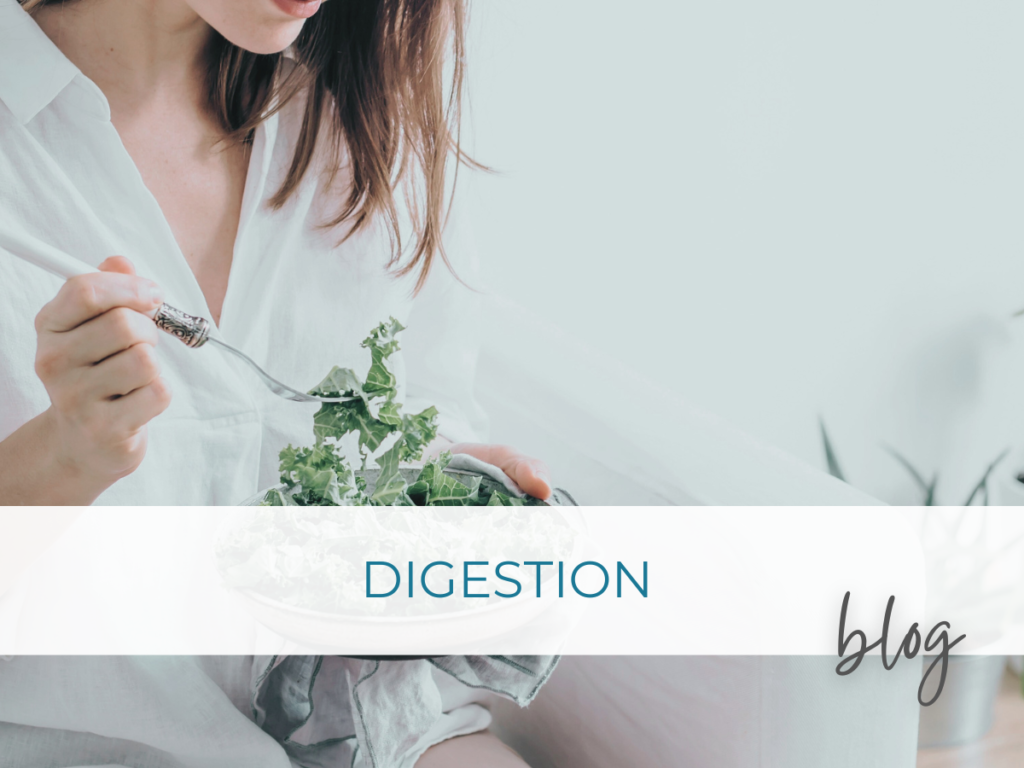The digestive tract is central to optimal health. The gut is responsible for breaking down and absorbing nutrients, from the nutritious food that we eat. It is also responsible for the removal of wastes from the body. Good digestion means the absence of discomfort, optimal absorption, and motility.
The Break Down of Food and Absorption of Nutrients
The upper gastrointestinal system is composed of the STOMACH which produces HCl, hydrochloric acid, or stomach acid, the GALLBLADDER which stores and concentrates bile from the liver and the PANCREAS which secretes enzymes. Collectively, we refer to HCl, bile and enzymes as “digestive juices”.
Digestive juices break down proteins, fats and proteins which is essential to extracting all the nutrients from our food. It might be worth mentioning that digestion starts in the mouth, with chewing. That’s right, chewing is so important! It is important that we slow down our eating, eat in a calm “rest and digest” state and chew our food, likely more than most of us do.
We can test our digestive function through some easy and some more extensive testing. HCl sufficiency can be tested through the HCl challenge or through the Burp Test (yes, the burp test!), and through these tests a Naturopathic Doctor might diagnose HYPOCHLORHYDRIA, or low stomach acid. Common symptoms of hypochlorhydria might include fullness immediately after eating, low appetite, vitamin and mineral deficiencies and some skin symptoms such as acne and rosacea.
Adequate BILE PRODUCTION can be tested as steatocrit, or fat found in stool and PANCREATIC FUNCTION can be tested through stool elastase which is one of the pancreatic enzymes that has been shown to represent levels of all the pancreatic enzymes. Symptoms of low bile production show up as difficulty digesting fats and low pancreatic enzymes often look like bloating, poor appetite, aversion to meat and heavier meals.
The Small Intestine is for Absorption
The SMALL INTESTINE is a long 20+ foot tube, that is located between the stomach and the large intestine. Its main role is absorption of nutrients. We need a healthy small intestine to absorb all the healthy food we eat and high-quality supplements we take!
Inflammation Can Reduce Nutrient Absorption
If your small intestine is inflamed from a food that you are eating or from an overgrowth of bacteria called SIBO (Small Intestinal Bacterial Overgrowth), or Celiac Disease, you might be deficient in nutrients even if you are eating a healthy diet and/or supplementing.
Food Sensitivities
I once heard a doc say, if you have white spots on your nails, that’s gluten sensitivity and that’s that! My first thought was, no that’s zinc deficiency, which it is, but then I began to wonder, why is someone zinc deficient, especially if they are consuming enough zinc? Could a food that a person is sensitive to be inflaming the small intestine and preventing absorption of nutrients? Yes! Interestingly, I use a zinc taste test, called the Zinc Tally to reflect nutrient absorption.
A Naturopathic Doctor will often test for food sensitivities to look for such causes of inflammation. The test is called IgG Food Sensitivity Testing and is not to be confused with IgE Allergy Testing, done at the allergist, which is looking for acute reactions (think peanut allergy). Naturopathic Doctors also test for nutrients that might be deficient, including Vitamin D and iron, through simple blood tests and use functional medicine testing to assess for other nutrient deficiencies.
Celiac Disease
Naturopathic Doctors often talk about food sensitivities and gluten intolerance. Celiac disease is a condition of severe gluten sensitivity where gluten triggers the immune system to inflame and damage the small intestine. Symptoms can include diarrhea and abdominal pain, recurrent apthous ulcers (canker sores), multiple nutrient deficiencies, fatigue and weakness. The screening test for Celiac Disease is a simple blood test.
SIBO
SIBO stands for Small Intestinal Bacterial Overgrowth. It’s a condition characterized by the presence of an abnormally high number of bacteria in the small intestine, where bacterial populations are typically lower compared to the large intestine. SIBO occurs when bacteria from the large intestine migrate upwards into the small intestine. A key point to note here is that these bacteria are not pathogens, they are normal occupants of the GI tract.
Symptoms of SIBO are caused by the fact that you have too much bacteria in a closed, 20+ foot tube and bacteria like to produce gas. The gas gets trapped and will either go OUT (bloating) or UP (heartburn, burping) as the gasses from below push acid from the stomach into the esophagus. Imagine the gas trying to make its way out of the 20-foot-long tube. That pressure of the gas on the small intestine can cause discomfort and pain.
Foods that can trigger symptoms can often be the healthy ones (foods we want you to get back in your diet eventually). They are often rich in complex carbohydrates and fibres (FODMAPS), foods like apples, broccoli and family, garlic, onions, lentils and beans. When you eat these high FODMAP foods, it is essentially feeding the bacteria in the small intestine which causes them to produce lots of gas! Some red flags for SIBO are bloating from apples or other foods on the list, or bloating as the day goes on. When you have been fasting overnight, there is nothing in the small intestine for the bacteria to feed on, but as the day goes on, and you’ve been eating, the bacteria become active and start producing gas.
Diagnosis of SIBO typically involves a breath test to measure the levels of hydrogen and methane gas produced by bacteria in the small intestine.
The Essential Microbiome
The gut contains trillions of bacteria known as the microbiome, which plays a role in digestion, immune function, Vitamin K synthesis and nutrient absorption. Adequate quantities and variability of our normal flora is essential for health including immune function, mood, neurological function, and hormones. The microbiome can be tested through a urine test called the indican test and through comprehensive digestive stool analysis.
Assessing Your Gut Motility
The LARGE INTESTINE or the COLON is responsible for elimination. Simply put, to assess optimal motility, you need to look! Ever heard of the Bristol Stool chart? If not, you should look it up immediately. The goal is the Bristol 4, or the S-shaped poo, called this as it is a complete bowel movement that completely empties the sigmoid colon, which happens to be S-shaped.
Ways to improve motility include adequate water and fibre intake, avoiding being sedentary and strategies to improve colon tone including colon hydrotherapy.
That’s the digestive tract from top to bottom!








